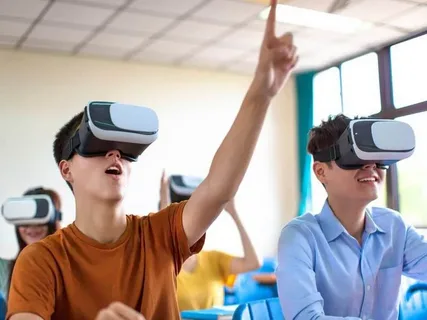Uses of Virtual Reality in Education
Education is one of the most fertile grounds for virtual reality to gain a real foothold. With virtual reality, students can get immersed in learning materials in ways one never dreamed possible before the advent of virtual reality. This article will uncover how virtual reality has revolutionized education, from better engagement to new ways of getting hands-on with learning, and evidence of how this cutting-edge technology is redefining the way education is imparted.
Enhancing Student Engagement
Increasing student engagement is one of the biggest uses of virtual reality in education. Often, complex subjects make it difficult to capture students’ attention in traditional classroom settings. In virtual reality, students can swim in environments that have them diving into 3D models, simulations, and dramatic scenes. Information becomes more interesting and easily known to students in this dynamic learning experience that keeps students focused and interested.
Hands-on learning experiences are offered
Virtual reality lends itself to the hands-on learning experience that can not be attained through traditional teaching methods. In science, technology, and medicine, students can do virtual experiments, dissections, and even virtual surgeries inside a secure virtual field. Students are taught through this hands-on approach to practice and develop skills in a safe environment, and this is reflected in practice over learning by reading and listening.
Developing in bridging the gap between distance learning
As more and more things go online, virtual reality has become a reality that bridges the gap in distance learning. Virtual classrooms provide presence and interaction just as a real classroom would. Students could wear VR headsets and join virtual lectures with people anywhere in the world, discuss things within groups, and participate in lectures with other students globally. They also create a sense of connection and participation, which increases the levels of interaction as well as the effectiveness of the online learning process.
Making Abstract Concepts Real
It’s hard to understand abstract concepts in subjects like mathematics or science. By making these concepts more tangible in a virtual reality, the 3D environment helps students see and manipulate them. For example, physics students can try force and motion; maths students can play with difficult geometric shapes. Students find it easier to understand difficult concepts using this interactive exploration, which has provided them with a concrete representation of abstract ideas.
Real-World Scenario Simulations
Virtual reality is one way education can work to simulate real-world scenarios. Students can do so in engineering, healthcare, and architecture in realistic virtual environments. For example, medical students can perform surgeries on virtual patients; architecture students can use their designs in 3D. These simulations are realistic so students can practice real-world things in a safe, controlled environment.
Enhancing Special Education
Virtual reality is also proving to be a rich resource for special education. Students with learning disabilities or sensory impairments can also adapt to the virtual environments according to their requirements, making them flexible enough to enable customized learning experiences. With virtual reality, educators can modify lessons that work for all abilities and learning styles in a customized environment where students can learn at their own pace. At its most personalized, education is the most equitable and inclusive for everyone, especially vulnerable learners.
Supporting Language Learning
Learning a new language is tough, but virtual reality is the best way to learn a new language. VR environments can contain meeting places where students can learn to speak and listen in real contexts. For example, language students can “visit” a virtual market or tour a museum in the target languages. Through language in context, this immersive experience allows students to actualize vocabulary and grammar through hands-on practice in the authentic world.
Collaboration And Teamwork Encouragement
Today, collaboration and teamwork are important skills that virtual reality in education can help students develop by allowing students to work together in virtual environments. Activities such as learning from virtual classrooms, labs, or project spaces allow students to work together to complete the project, do experiments, or solve problems. It helps to develop communication, problem-solving, and team-building skills that help students develop skills for working in collaborative environments.
Making sure our Environment is Safe for Learning
Where virtual reality can be used in fields that require hands-on training but can be dangerous, let’s take firefighting as an example; for example, students in fields like surgery or those training in hazardous materials handling can use VR to practice skills that won’t endanger themselves. Students get a safe, controlled place to make mistakes and learn from them without real consequences. They graduate with the ability to do the work and the confidence and competence to do it.
Turning traditional classrooms into learning spaces
Virtual reality is also changing classrooms as part of its integration into education. VR differs from passive learning from textbooks and lectures, where instructors teach content and hope followers fill in the gaps; instead, it stimulates curiosity and creativity through interactive experiences. Students can virtually travel through ancient civilizations or learn anatomy in 3D. These are just a few ways history teachers bring their lessons to life. The change in the learning environment provides for a more engaging and enjoyable education that leads to increased participation in active learning and a growing love for learning.
Conclusion
Virtual reality transforms how students learn and come in contact with knowledge. Even beyond adding real-world role play into real-world activities, VR also offers immersive, interactive experiences that not only provide hands-on learning but improve accessibility and bring abstract concepts to life. With advancing technology, virtual reality will give way to even more opportunities for learning, with learning becoming more engaging, inclusive, and effective. The adoption of VR in education could be a vehicle to unleash a generation of learners to lofty heights and enjoy a different world than ever before.

















